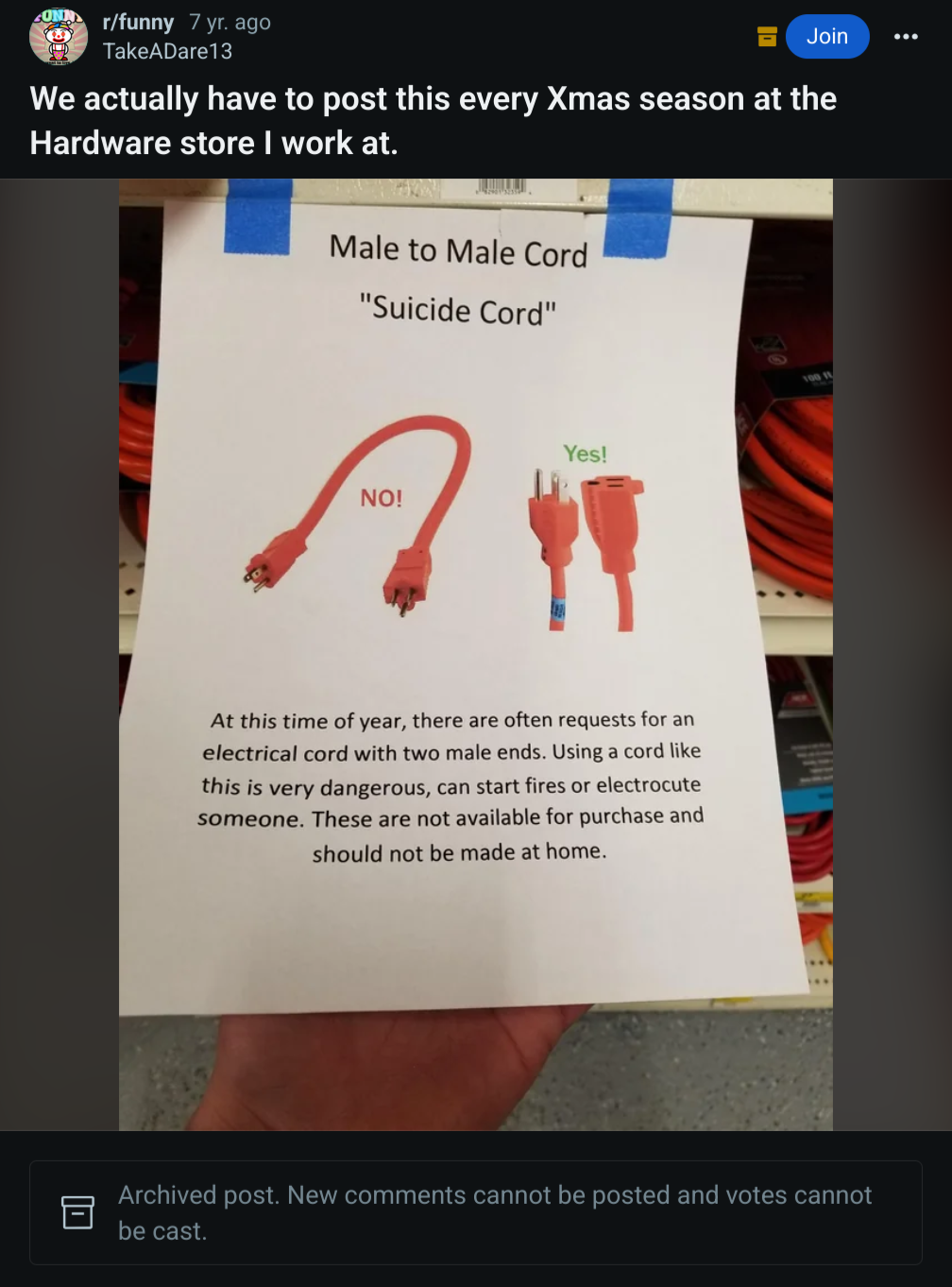
Happy cake day!
what a year huh ty!!
No gay cords allowed!
The gay cords are extra powerful in Europe with a spicy 230v
1 European gay is equivalent to 1.91 american gays
Joke’s on them I can make one myself
But the paper said you shouldn’t
What if I yell “no homo!” when I plug it in?
where are you plugging it in?
I mean, there’s only one place for double-headed items to be safely used and it isn’t in the workshop.
…the kitchen?
My granpa once assigned a master electrician to make an extension cord after he accidently cut the cable of his hedge trimmer. The electrician built him a male2male cord with the female part on the machine. My granpa almost got electrocuted. 🤦♂️
I have heard there are ways to use these to back feed power from a generator into a house’s system, at least on one breaker, but by definition that bypasses the breaker panel, and the only safe way to use your generator for your house is with a proper cutover installed by an electrician. I can think of literally no other use for one of these cords, except maybe fixing your fuck up if you install Christmas lights backwards.
So yeah, dumb, dumb idea.
There are voltage converters (230V<->120V) that have female connectors in both ends. So if DIY guys are playing with tech from other continents.
I don’t understand why it would have female on both ends?
Yeah. Makes no fucking sense

I searched that model number, and came up with a similar looking box that has a corded male end- implying that those two stickers are outputs.
deleted by creator
Weird use case. Never underestimate the customer.
Any serious DIY person can just splice an extra male plug onto a cord faster than driving to the store and reading this sign.
I’ve heard the Christmas lights one before too, but I never got it. How do (American) Christmas lights work that you’d need one of these cords?
In North America, Christmas lights usually have a plug end and a socket end so you can connect multiple strings together in series.
If you accidentally put the plug end at the top of the tree, it might be tempting to try to buy or make one of these cords so you don’t have to take the lights down and redo them.
It is as dumb and lazy as it sounds.
So if I understand it correctly, if you were to use this “solution”, you’d leave live exposed prongs on one end of the lights, right?
Cause that would make it even dumber than I had imagined lmao
Yup. American Christmas lights basically ARE very thin extension cords with the bulbs (hopefully) wired in parallel. Back in the day they were pretty much all incandescent and in series, and a single burned out bulb meant everything went out and Junior got a joyous new holiday chore!
Yep. Exactly right.
It also backfeeds the grid and can kill someone working on the lines.
This is the real issue and why you need a modern transfer switch. Lineman is working on the transformer on the pole, “it’s fine we cut it off upstream and I checked” and BOOM anyway
My friend’s house does this with their generator. There is a lockout on the breaker, and the main must be off to move it and open the one that feeds the back porch where they tie the generator in. Once the breakers are cycled, they can plug the generator into the outlet on the porch, and it runs there, sheltered from the weather. When the main power is working again, they turn off the generator, remove the cord, disable the breaker, toggle the lockout bar, and turn the main back on. The particular outlet on the porch is useless when using grid power because of this setup.
So if it’s only for the generator, why is it wired as an outlet, not an inlet?
This is all reasonably accurate. Source: electrician, who worked at a supply store for a while. I’ve had people ask how to make all kinds of stupid cords.
If you don’t know what you’re doing, don’t fool with electricity
The problem is that people read a few things on the internet, think they’re now suddenly domain experts, and do it anyway.
Oh I know.
I’ve talked to them.
Don’t do it. If you haven’t actually worked with an electrician for at least two or.three years, just leave the repairs and shit jobs for people like me.
If you can’t explain why the white wire is incorrectly called a neutral in single-phase systems, don’t touch it.
Unionized Kobold electricians. Hmm.
“this time of year” is 100% christmas.
from people putting up lights, probably trying to run remote power to a box with an extension cord, or because they installed half their lights backward and need this to bridge between the two sets because they rather embrace the danger than redo all the work.
It’s OK - I’m only going to use the suicide cord for my fractal wood-burning project.
Well at that point all you need to do is cut a normal extension cord and strip the ends. Maybe add a switch or a button for extra safety.
So what you are telling me is that I can just make one at home?
Yes, but only once.
No.
yeah, that’s some counter-productive signage.
like getting on a bus and seeing:
please don’t
GROPE STRANGERS
Titty squeezy
They cant stop you from buying heat shrink and wire strippers. Don’t let nothing hold you back
Nothing can hold me back. Because I am stuck in place by the electricity coursing through my body.
you don’t even need heat shrink if you have the good plugs which can be unscrewed open

Sorry, what is “this time of the year”? Suicide September?
People use them to make their generators power their homes, by adding power into an outlet.
So, whatever time of year power outages are likely to happen in this area.
Holy shit, does that work?
I’m only familiar with having a generator properly wired into the house system at the panel, not some electrical Uno Reverse.
yes, it would (possibly) work, but you’re likely to run into quite a few safety-related issues outside of using the suicide cord. the fact that you’re probably injecting power downstream from any RCD units or even any basic current breakers, leaving you open to electrocution, or worst case, fire. the other issue is if you dont isolate your home from the grid before doing thus, then when the grid comes back (and your generator is still… generating) there’s likly to be a loud bang and a dead generator, let alone the risks you put on any workmen who are working on the lines they are expecting to not be carrying current.
TLDR; unless your hourse is specifically wired for this, and you have the necessary protections in place, just use an extension cord and plug your fridge directly into the generator. 🤷
If you have to ask, don’t do it.
The proper way to connect a generator is with a breaker panel interlock. This gives you a circuit breaker for the main, grid power; a second breaker for the generator; and an interlock device that only allows one of those two breakers to be active at any given time.
Trying to use a suicide cable can get power into the house; disconnecting the main breaker would prevent the generator from back feeding the grid. However, the circuit you are plugging the breaker into is only rated to 15 or 20 amps, and you’re backfeeding it with a lot more. You can easily overload this circuit without actually blowing a breaker.
There’s other problems as well: your house wiring is designed for two opposing hot, 110v phases. These are combined to provide 220v power to major appliances. Improperly backfeeding your wiring can potentially damage those major appliances.
You are better off with a nice, heavy-duty extension cord than a half-assed suicide cable.
Lol, not going to do it. Been mildly electrocuted too many times to mess around with something like this.
More so curious about the physics here, but I see it’s basically a roll of the dice that it does work and doesnt just fry everything.
It does, but it’s super dangerous to do unless you have it wired up properly. Proper installations will use a special connector so you can’t plug anything else into that receptical, and will have it interlocked against the main breaker - you can’t plug anything in without disconnecting from the grid. The dangers of doing it amateur-hour are:
- You now have a cable that you can unplug and have live ends exposed - which if you don’t realize is connected to an active generator is super dangerous, and even if you do one slip and you are now the ground conductor
- If you connect the generator while still connected to the grid, your generator is almost certainly going to be out of phase. This will probably cause damage to your generator and anything else plugged in at the time
- If you don’t have an interlock and run the generator while connected to the grid (say during a power outage) you will be back-feeding power into the grid. This is super dangerous for anyone coming to fix the outage, as things that they’ve isolated to fix can still end up being live
Note that this interlock is also required if you have solar - although it’s usually in the form of an automatic breaker that will disconnect and put the circuit into “island mode” if it detects a loss of grid supply
I did it last week. We were out of power for about 30 hours. But I actually have a degree in Computer Engineering, and I did it with a friend who is a professional Electrician.
It is indeed EXTREMELY dangerous. If you don’t know what you’re doing, or make a mistake, best case scenario, you fry your generator. Worst case, you electrocute a lineman from the power company, who isn’t expecting lines to be live when there’s an outage, because yes, if you feed power into your house, that will flow OUT of your house onto the main lines (to some extent), if you let it. You could end up trying to power your whole block on your little gas generator.
We made sure both the indoor and outdoor main power shutoffs for the house were turned off, as well as all breakers. Then we unplugged the oven, and used that for the feed from the generator. Then we gradually re-activated breakers so as not to add too much load to the generator at once. Ultimately, we were able to run the whole house, except for the AC compressor, which the generator actually would have had enough power to run, but not to kick-start.
The proper way to hook up a generator to feed your house is to install an “inlet” which is both nominatively and physically the opposite of an outlet: instead of holes going into a box, you have prongs sticking out of a box. Generally, it’ll be one of the big fat 4-pronged round cables, like what your oven might use. That’ll feed down to a large double-breaker, in the top-right slot of your breaker panel. That breaker stays off until you want to run a generator, and, to meet code, you have to also install a special bracket that prevents you from turning this breaker off without turning off the primary feed for the whole house. Still kinda dangerous, but they make those brackets surprisingly foolproof.
except for the AC compressor, which the generator actually would have had enough power to run, but not to kick-start.
This sentence triggered my PTSD. Imagine, if you will, a world where executives insist that datacenter AC be put on UPS battery. A world where those same executives declare that a different datacenter is just fine running at 95% power capacity because “it’s not 100%.” A world where inrush current does not exist. Except it does exist, but all professional advice is ignored until there are consequences. And even after such consequences are realized, one of those same executives still tries to run his home sump pump off of a desktop UPS during a power outage, pops it immediately, then goes and gets another from the office, which also pops immediately.
The sign in OP’s post will always be relevant somewhere.
deleted by creator
I’m gonna guess winter, hanging Christmas lights. People string up their lights and then realize far too late that they put two strands with female ends facing each other and instead of restringing they look for a male-to-male cord to bridge the gap.
A little live wire shouldn’t stand in the way of holiday cheer, after all.
That would immediately blow the fuse in the lights and/or start a fire if the two strands were on different circuits that happened to be on different electrical phases.
While I wouldn’t doubt that some people are stupid enough to do that, it’s actually summer that it’s done the most for because of storms and power outages, and people learn that backfeeding is a thing (that you shouldn’t do unless you absolutely know what you’re doing).
I appreciate a good “um actually” but this really is about Christmas lights. People really are stupid enough for this to be something posted specifically around December.
As far as I can tell from a reverse image search this is the original. (Not linking to the other place, DM me if you want the link for some reason).

Fair enough. I shouldn’t be posting within 30 minutes of waking up anyway…
Never underestimate stupidity. Though I do think it’s at least not normally people trying to connect two strands that are themselves already live. It’s normally people who are connecting several strands together and started at the end not plugged in with the male end poking out, not realizing that this means when they’re done stringing and go to plug in they’ve got the female end and no way to plug it in.
Left facing the daunting task of completely undoing all the work they just did, they try to look for something to bridge the gap without thinking through to the danger.
A former coworker was abroad most of the time. Still, his power meter showed lots of usage during his absence. A tenant in the same house had used such a cord to leech power across the common laundry room.
Now that coworker knew his way about electricity. So instead of the 220V between common and a phase, he rewired his washing machine socket to two different phases, aka 380V, and left for a week.
When he came back, he saw a number of kitchen- and other appliances waiting for trash collection.
3 phase going to a house?
Absolutely normal here. Three phases, now 400 instead of 380V back then, 64A. Standard house connection.
In the States the new standard is 240V @ 200 amps, split phase. Most circuits are half of a phase (120V) but there are 240V circuits for load-heavy appliances like stoves and air conditioning. I’ve heard some people have an extra 240V socket in their kitchens just for tea kettles.
These-phase 400V is the standard house connection here in Europe. Wall sockets are 240V/16A (any phase to neutral), but we also have devices running on three phases, like the oven or the geyser in the kitchen.
Do they put a third of the panel on each phase?
Short answer: Yes.
There are actually so-called “three phase combs” for the fuse panels: Sample Image. You put your fuses on a hat rail (in this case eight fuses, but those combs are available in different sizes), you stick that comb in from below and tighten up the screws. Then you connect the three phases to the connections on the left, or, in some fuse boxes, screw them right onto the bus bars.
That is so clever! I hate working with high voltage but am still fascinated by it.
Take it down, darwin demands sacrifice, lest we be riddled with stupidity.
Except that sometimes, those idiots could take people down with them. That electrical fire might spread to another house, and the person getting electrocuted might not be the idiot.
Imagine I’m making the most exasperated, annoyed, disapponted noise possible.
Removed by mod
Today I learned that by being someone’s neighbor, I’m viewed as “choosing to engage with them”.
He didn’t take it to the store and tape it to the shelf so it could NOT be there
K
It is written in the book of Leviticus: “It shall be unclean for one end of an electric cord to match the other”
Holy shit, this is what that part in the bible is actually about. People back then just didn’t know about electricity so they thought it was about gay people.
honestly tho. if the Torah is legit its advice should apply to the future too. haShem wouldn’t just have been writing to Moishe’s time.














